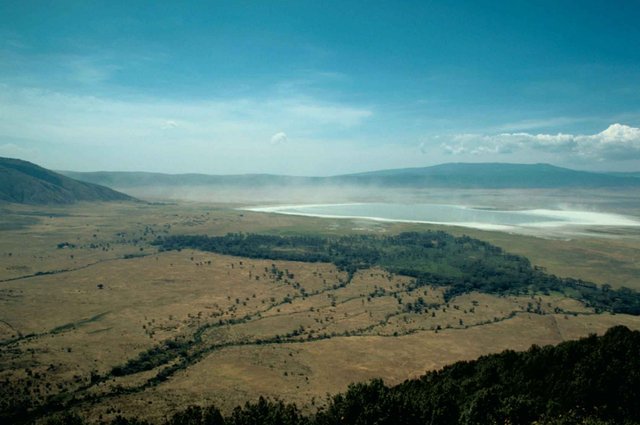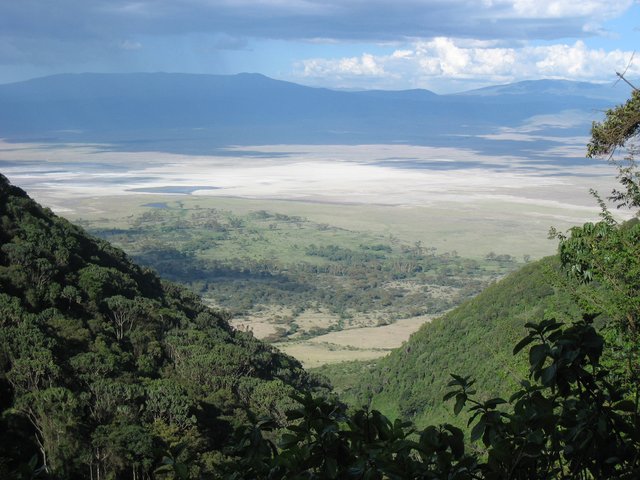Wonders of nature. Ngorongoro Crater

The huge crater of the volcano, isolated from the surrounding plains, has become a real paradise for animals
Outside, the steep slopes of the crater of an ancient extinct volcano (1800 m above sea level) in the north of Tanzania are covered with dense thickets, and looking at them, it is difficult to imagine what is behind these walls.
From the top of the slope there is a breathtaking view. As if the earth fell down into a vague emptiness, forming a gigantic bowl. At first it is difficult to get used to the dizzying extent of the opened space. The eye stops only on the thin threads of creeks at 600 meters below, wriggling and pouring into pinkish lakes.

Sand particles are scattered along the bottom of the crater black dots; and only when they begin to move, changing shape, like a cloud, it becomes clear that these are thousands of grazing antelope and wild zebra. Suddenly, a wave of movement passes through the lakes, and pink spots rise into the air, swirl and again sink to the water. These are huge flocks of flamingos that gather here on small lakes.
At the bottom of the crater area of 260 square kilometers, one of Africa's largest clusters of wild animals — about 30 thousand heads. Here live almost 50 different species of large mammals: lions, elephants, rhinoceroses, hippos, giraffes, various antelopes, including cannes and impali, marmosets, lambs, baboons, warthogs, hyenas. More than 200 species of birds nest in the crater, including ostriches, ducks and guinea fowl.
Crater Highlands
This natural Noah's Ark is a happy geological accident. Ngorongoro lies on the eastern tip of the East African rift system, passing from Mozambique to Syria. At various times for millions of years, tremendous pressures in the center of the Earth tore the earth's crust in the weakest places, and the molten magma was squeezed out onto the surface in the form of a group of volcanoes now forming the East African Crater Highlands.
Ngorongoro also belongs to this group. Once it had a conical shape and was approximately 2 times higher than it is now. But 2,5 million years ago its molten lava splashed outwards, and the top of the volcano fell into the crater, forming a caldera, inside which rises the hill of the Round Table.
According to the size of Ngorongoro — the sixth of the largest calderas in the world — about 18 kilometers in diameter. But this is the largest caldera with walls that have survived along the perimeter. The African name of the Ngorongoro crater is simply a "big hole".
Unlike the animals of the Serengeti highlands, which migrate every year in search of water and new pastures, most of the inhabitants of Ngorongoro remain in the crater all year round: the water here is accessible even in a drought. Two sources and two rivers — Mundzh and Lonokyo — feed several marshes and the main lake with alkaline water — Magadi.
Without a drain, the lake has a high concentration of salts accumulated over the centuries as a result of the evaporation of water, and under certain illumination they give the lake a bright blue color. Only algae and some small crustaceans can survive in such water, but this is quite satisfactory for the millions of flamingos that feed on them. Here live two species of them: red and small. In the neighboring marshes there are mud pits where the hippopotamus rushes, as well as the watering of elephants and black rhinos that come there accompanied by buffalo starlings. These birds feed on parasites, which are hacked out of animal skins.
Rain and refresh
Every year after the "long rains", pouring from December to May, the plains on the bottom of the crater are covered with emerald grass, over which the pink, yellow, blue and white flowers are generously scattered. Here you can see petunias, lupines, daisies and a rare blue clover. As the dry season approaches, which lasts from May to November, the crater gradually changes its color from green to yellow, then beige and light brown, and the animals gather near the Mundzhi bog.
The crater is fenced off from the surrounding world, and the inhabitants of Ngorongoro do not have to go for long searches of what they need for life. Herbivores, such as antelope and gazelles, feed directly under their feet, and they serve as food for predators - lions, leopards, cheetahs, hyenas and jackals. Predators roam around grazing herds, like careless robbers from a big road, waiting for the victim behind the herd. Herbivores bring their offspring mainly in January-February, when the grass is especially juicy, and predators also multiply at this time, because many newborn calves and foals, which are easy prey for nursing mothers and suckers.
So in this paradise garden is not like in paradise. The excitement that encompasses the herd of antelope-gnu at the sight of a yawning lioness, the rapid leap of Thompson's frightened ghazal, the flapping of the wings of the flamingos that run all the way from the hyena's walker, all means that one must be on the alert to survive in this tightly programmed community. And the vultures hovering over some new place of murder symbolize the final stage of the daily ritual of death.
Living laboratory
For many years zoologists and other scientists have come here to explore this unique balanced ecosystem. Unfortunately, its future is far from cloudless. Scientific analysis of the lion population revealed that the entire hundred lions inhabiting the crater are descendants of only 15 individuals. Each of these 15 either experienced a terrible invasion of bloodsucking flies in 1962, or wandered into the crater a little later. This means: the gene pool of Lions of Ngorongoro is very limited, which negatively affects their resistance to diseases and fertility.
Every year several animals leave the crater along ancient paths. They join animals that migrate during the dry season to the plains below, and then return. These animals make up only a small fraction of the total, but they introduce new genes into the closed communities of Ngorongoro. However, the development of agriculture in the surrounding areas can destroy these migration routes, which will lead to even greater isolation of the crater.

Once Ngorongoro was part of the nearby Serengeti National Park, where it is completely forbidden to engage in agriculture. This was put at the very disadvantage by the Maasai people living at the expense of cattle breeding; so in 1959 the crater and its surrounding area with a total area of 830 square kilometers were declared only a restrictedly guarded territory. However, the number of cattle in the crater is strictly limited, and any increase is forbidden.
The gracious, full-blown Masai, with hair dyed red, in cloaks tied with a knot on one shoulder, their soft tread, the rustling of burnt grass, the sharp smell of animals — everything develops in that aura of eternity that envelops the ancient earth.
Tanzania looks amazing such ancient land
Congratulations! This post has been upvoted from the communal account, @minnowsupport, by Mamasetta from the Minnow Support Project. It's a witness project run by aggroed, ausbitbank, teamsteem, theprophet0, someguy123, neoxian, followbtcnews/crimsonclad, and netuoso. The goal is to help Steemit grow by supporting Minnows and creating a social network. Please find us in the Peace, Abundance, and Liberty Network (PALnet) Discord Channel. It's a completely public and open space to all members of the Steemit community who voluntarily choose to be there.